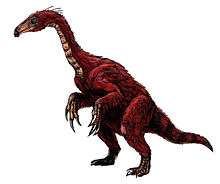Segnosaurus
| Segnosaurus Temporal range: Late Cretaceous, 90 Ma | |
|---|---|
 | |
| Skeletal restoration | |
| Scientific classification | |
| Kingdom: | Animalia |
| Phylum: | Chordata |
| Order: | Saurischia |
| Suborder: | Theropoda |
| Superfamily: | †Therizinosauroidea |
| Family: | †Therizinosauridae |
| Genus: | †Segnosaurus Perle, 1979 |
| Species: | † S. galbinensis |
| Binomial name | |
| Segnosaurus galbinensis Perle, 1979 | |
Segnosaurus ('slow lizard') is a genus of herbivorous theropod dinosaur belonging to the Therizinosauridae from the Cretaceous of Mongolia.
Discovery and naming
In 1973, a Soviet-Mongolian expedition near Amtgay uncovered the fossil of a theropod. In 1974 and 1975 more such remains were discovered, at the same site but also near Khara-Khutul. The type species, Segnosaurus galbinensis, was named and described in 1979 by Dr. Altangerel Perle. The generic name is derived from Latin segnis meaning 'slow' or 'sluggish' and Greek sauros meaning 'lizard', in reference to the stocky build of the hindlimbs. The specific name refers to the Galbin region.[1]
Four specimens were recovered from the Bayan Shireh Formation of the Mongolian People's Republic, in sediments dated between the Cenomanian to Turonian stages (Late Cretaceous Period, about 93 million years old).[2] These include the holotype, IGM 100/80, a partial skeleton consisting of a mandible, pelvis, right thighbone, scapulocoracoid, incomplete forelimb and sacral and caudal vertebrae; and the paratypes IGM 100/82 and IGM 100/83, both more fragmentary skeletons also lacking the skulls.[1] Later specimen IGM 100/81 was referred, a foot.
Description

Segnosaurus was a rather large therizinosaurid. In 2010 Gregory S. Paul estimated the body length at 6 metres (19.5 ft), the weight at 1.3 tonnes.[3] Segnosaurus had an elongated head, large clawed hands, a somewhat elevated torso, a broad strong pelvis, stocky legs and a short tail.
Segnosaurus can be distinguished from all other therizinosaurs on the basis of two unique derived traits (autapomorphies). The in total forty-eight mandibular teeth are markedly peg-like and only slightly recurved: the front or mesial edge is curved and the back or distal edge is straight. The second autapomorphy is that the claws of the hand are rather flat instead of very narrow.[2] In the same formation the closely related Erlikosaurus is found; Segnosaurus can be distinguished from this species by its moderate transverse compression of the pedal unguals or foot claws.[1] Also the latero-dorsal shelf on the dentary, a flat bone surface at the upper outside of the lower jaw, starts at the fourteenth dentary tooth position and runs backwards for half the length of the lower jaw, unlike the shelf in Erlikosaurus, which starts at the fifth tooth position. This would have indicated that Segnosaurus did not have as extensive 'cheeks' as Erlikosaurus is believed to have had.
Phylogeny
Perle in 1979 assigned Segnosaurus to the Segnosauridae.[1] He correctly inferred that these were theropods, an opinion not unanimously confirmed by Western scientists until the 1990s. At that point it also became clear that Therizinosaurus was a close relative and the group therefore actually was called the Therizinosauridae, a name having priority, and that these forms were plant-eaters instead of fish-eaters as had originally been presumed by Perle.
In popular culture
Segnosaurus was featured in Robert Bakker's novel Raptor Red. In this novel, it was portrayed as a burrower. Despite this, Segnosaurus is not known from Early Cretaceous Utah, though its more primitive relative Falcarius is.
See also
References
- 1 2 3 4 A. Perle, 1979, "Segnosauridae - novoe semeistvo teropod is posdnego mela Mongolii", Trudy - Sovmestnaya Sovetsko-Mongol'skaya Paleontologicheskaya Ekspeditsiya 8: 45-55
- 1 2 Lindsay E. Zanno (2010). "A taxonomic and phylogenetic re-evaluation of Therizinosauria (Dinosauria: Maniraptora)". Journal of Systematic Palaeontology 8 (4): 503–543. doi:10.1080/14772019.2010.488045.
- ↑ Paul, G.S., 2010, The Princeton Field Guide to Dinosaurs, Princeton University Press p. 159